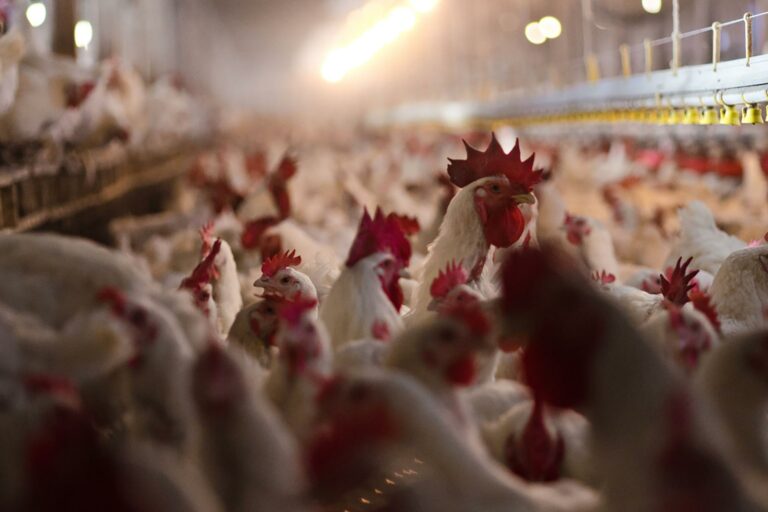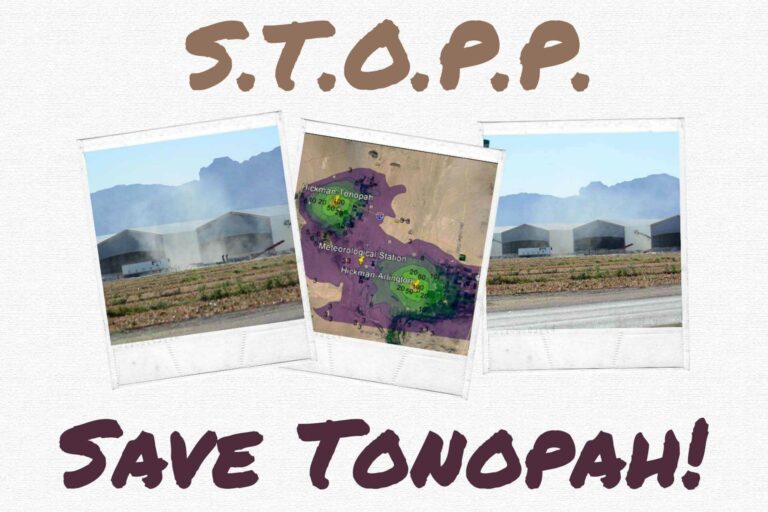Tonopah STOPP
Unveiling the Massive Scale
Exploring the sheer magnitude of the environmental issues facing Tonopah and Arlington due to Hickman’s egg-laying and manure-processing facilities.
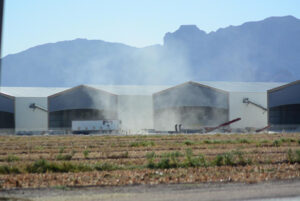
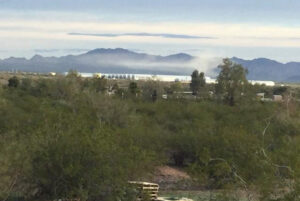
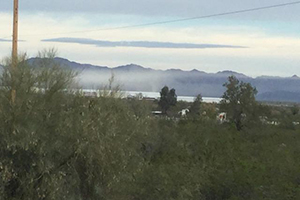
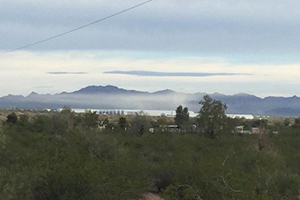
When trying to understand the magnitude of the problems the communities of Tonopah and Arlington are experiencing with the Hickman’s egg laying and processing facilities, along with the manure pellet manufacturing that occurs at the Arlington facility, the design of the facilities and the number of chickens there have to be examined.
Anyone who has had chickens knows that even a small number of them when confined can cause nuisance odors, so imagine what it means to have millions and millions of them.
There are huge barns that house the laying hens. These three-story barns are 84 feet wide and 714 feet long, which is over two times the length of a football field. The chickens are caged in rows that go up to the top of the barns, and their droppings fall onto a slow-moving conveyor belt that runs west to east, eventually depositing the manure into the manure storage barns that are on the east side of the barns. These are 126 feet of the 714-foot-long barns. The lay area is about 5 times as long as the manure storage area.
Fans blow from the west to the east 24/7 to ventilate the barns and to start drying the manure. Every few days, the manure is emptied from the east end of the barns and hauled away to the pellet manufacturing facility at Arlington.
The manure gives off ammonia and other chemicals that fill the air and affect people for some distance because the stench travels great distances.
If the levels of ammonia inside the barns get too high, vents open in the top of the barns, and ammonia and odors are vented outside. If the ammonia levels exceed 25 ppm in the barns, it can harm the chickens and even blind them.
Besides the constant flow of air from the barns due to the fans, when the barns are emptied of manure, there are huge releases of dust.
The dust is dried manure, chicken dander, and other materials. Local area residents describe having an instant asthma attack when they encounter this dust.
As you can see in this video, there are feathers and chicken dander that blow out of the barns.
After community complaints, some measures were taken by Hickman’s to lessen this, but it persists at some level.
Tonopah STOPP
Behind the Barn Doors
Peering into the design and operations of these colossal facilities, including the challenges posed by housing millions of chickens.

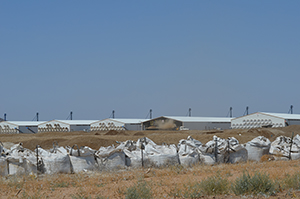
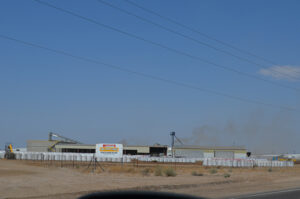
There are 14 lay barns at Hickman’s Tonopah facility and one more pullet house where younger replacement hens are grown. This Tonopah facility will be multi-phased with the ultimate build-out to consist of 28 large hen houses and two central egg processing plants. Periodically, the hens are culled, which means carbon dioxide is pumped into the barns and they smother. The corpses are ground up and processed into the manure pellets that are manufactured at the Arlington facility.
At full capacity and build-out, the Hickman’s Tonopah facility will have 4.3 million chickens. Hickman’s Arlington facility will have almost 6 million chickens and 2.8 million pullets.
The Arlington facility also has a manure dryer that heats up the chicken manure and other pellet components. Although there are not supposed to be thick clouds of smoke or dust released into the air by its operation, that is often what people see when they drive by. And drive by they can as the main public road runs right through the center of the Arlington facility.
The Arlington facility also has a manure dryer that heats up the chicken manure and other pellet components. Although there are not supposed to be thick clouds of smoke or dust released into the air by its operation, that is often what people see when they drive by. And drive by they can as the main public road runs right through the center of the Arlington facility.
Environmental Regulatory Agencies
Agencies responsible for regulating and enforcing environmental laws and regulations at the federal, state, and local levels to protect the environment and public health.
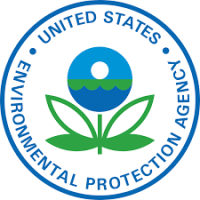
United States
Environmental Protection Agency (EPA)
The Environmental Protection Agency is an independent executive agency of the United States federal government tasked with environmental protection matters.
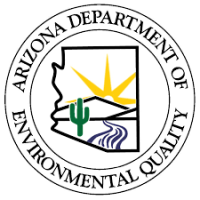
State of Arizona
Arizona Department of Environmental Quality (ADEQ)
Administrator for Arizona’s environmental laws and delegated federal programs to prevent air, water, and land pollution and ensure cleanup.
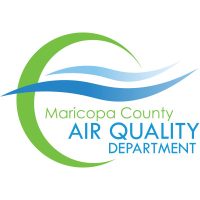
State of Arizona
Maricopa County Air Quality Department (MCAQD)
The Maricopa County Air Quality Department ensures that clean air standards are achieved and maintained for the people of Maricopa County.
Tonopah STOPP
The Invisible Threat: Air Pollution
Delving into the alarming air quality concerns, from ammonia emissions to volatile organic compounds, and the impact on local communities.
The other air pollution released into the air is very concerning. Poultry releases volatile organic compounds (VOCs), which form ozone over time distance, and heat, so downwind there will be more ozone formed. The Hickman’s facilities are upwind from the Phoenix metro area, which already has an ozone problem. The poultry facility VOCs were identified as 4-alcohols, 8-ketones, 5- esters/carbonyls, 9- carboxylic acids, 4- phenols, 8- Nitrogen-containing compounds, 4- Sulfur-containing compounds, 11-alkanes/alkenes, 3- aromatic compounds, and 3 halogenated compounds.
The total amount of VOCs emitted by the Tonopah facility is calculated to be between 6,021 tpy VOC (currently) and 8,429.6 tpy VOC at full build-out. [tpy = tons per year] This exceeds the minimum requirements for it to be classified as a major source of VOC air pollution.
The total amount of particulate matter emitted by the Tonopah facility is calculated to be between 473.1 tpy PM10 (currently) and 662.3 tpy PM10 at full build-out. [tpy = tons per year] This exceeds the minimum requirements for it to be classified as a major source of particulate matter air pollution.
The ammonia emitted from the Hickman’s facilities is classified as an extremely hazardous substance by the Emergency Planning and Community Right to Know Act. Chronic exposure to low levels of ammonia is a recognized health hazard. The federal agency, the Agency for Toxic Substances and Disease Registry (ATSDR) has set a standard for 365 days/year chronic-duration exposure to ammonia at 0.1ppm or 100ppb. This level is below the level that most people’s noses can detect, despite ammonia’s distinct odor. If a person is smelling ammonia, it is at a level that will eventually harm them.
This maps below were created by the Arizona Department of Environmental Quality to show what ammonia levels would be near the Hickman’s facilities. The figures used were an underestimation of the actual ammonia emissions, but the size of the impact is somewhat illustrated. http://dontwastearizona.org/tonapah17.php
Hickman’s Egg ranch was sued in federal court by Don’t Waste Arizona on behalf of its affected members in the Tonopah and Arlington communities for failing to provide the information required by federal law about its releases of ammonia.
Several additional nuisance lawsuits have filed against Hickman’s.
Hazmat Exposure Maps
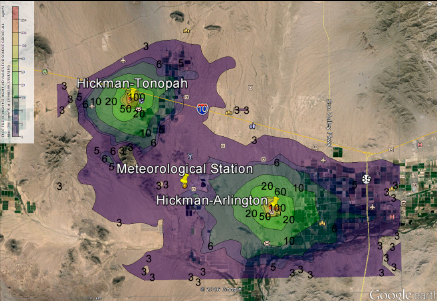
Hydrogen Sulfide
The federal standard for chronic exposure to hydrogen sulfide is 0.001 parts per million (ppm), which is equivalent to 0.000001 micrograms per cubic meter (µg/m³). This standard is used to regulate and limit exposure to hydrogen sulfide, a toxic gas with a foul odor that can have detrimental effects on human health even at low concentrations.
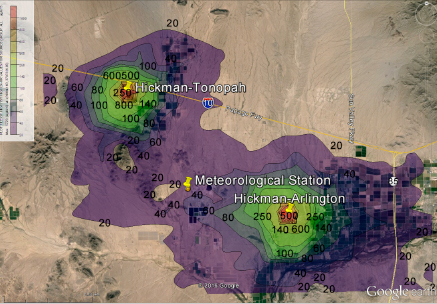
Ammonia
The federal standard for chronic exposure to ammonia is 0.1 parts per million (ppm), which is equivalent to 72 micrograms per cubic meter (µg/m³). This standard is used to regulate and limit exposure to ammonia, a chemical compound that can have adverse health effects on humans when present in the air at elevated concentrations.
Summary
In conclusion, these revelations shed light on the complex web of environmental and health challenges wrought by the extensive poultry operations at Hickman’s facilities in Tonopah and Arlington. The scale of these operations, the vast number of chickens confined within massive barns, and the intricate ventilation systems all contribute to a series of ongoing concerns.
As discussed, ammonia emissions, dust, feathers, and chicken dander continue to affect the well-being of nearby residents. The release of volatile organic compounds (VOCs) and particulate matter further exacerbates these environmental issues in an area already burdened by ozone pollution.
Federal standards, which regulate chronic exposure to ammonia and hydrogen sulfide, underscore the potential health risks faced by local communities. In response, legal actions have been initiated by concerned citizens against Hickman’s Egg Ranch.
In summation, these findings emphasize the urgent need for more comprehensive regulations and protective measures to ensure the health and environmental sustainability of these communities.
Save TONOPAH!
Support Our Cause!
Join us in standing up against harmful practices and ensuring a brighter future for our community. Every donation makes a difference!

